
|
KIT: |
Monogram 1/48 P-47D Thunderbolt |
|
KIT # |
6838 |
|
PRICE: |
$4.50 |
|
DECALS: |
One aircraft |
|
REVIEW : |
|
|
NOTES: |
` |

|
HISTORY |
For a historical overview of the P-47 Thunderbolt, see the earlier P-47D Razorback review.
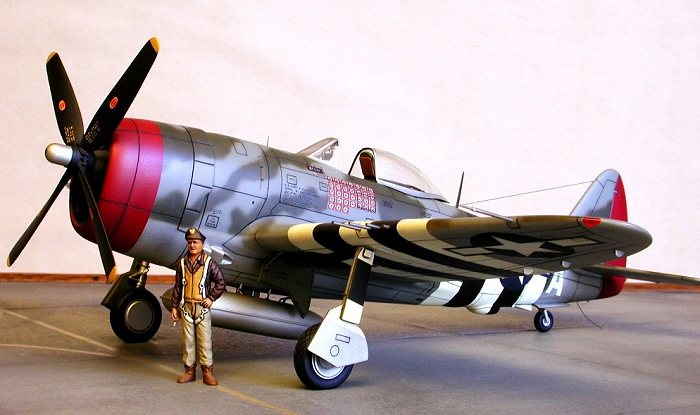
|
THE KIT |
Monogram’s P-47D Bubbletop kit contains 39 silver-gray parts, a clear two-piece canopy, and an instruction sheet offering a brief history of the aircraft, recommended assembly steps, and generic painting information. Decals are provided for one aircraft, specifically: 42-29147, a gaudily-marked NMF Jug assigned to the 509th FS, 405th FG, 9th AF, and nicknamed "The Turtle – No. 10".
Typical of its 1967 vintage, the kit features delicately-raised surface detail with recessed hinge lines for all control surfaces and the cowl flaps. The airframe assembles conventionally, with right and left fuselage halves, two-piece wings, and a pair of stabilizers. A one-piece R-2800 engine fits snugly into a separate cowling, though this molding technology reached and passed its zenith twenty-five years ago.
The undercarriage is well-depicted with adequately detailed wells, struts, and door interiors. The wheels are hub-covered with diamond tread on the tires, while the tailwheel door assembly correctly portrays the canvas boot inside. The Hamilton Standard Hydramatic prop is one of this kit’s highlights, beautifully cast, with accurate pitch and twist angles, along with correctly shaped and contoured tips.
Like the engine, the cockpit is rather lackluster, featuring a one-piece tub with an integral seat. State-of-the-art in 1967, the interior will benefit greatly from a resin upgrade set or scratch-building. A separate control stick and instrument panel are furnished, while a two-piece seated pilot figure is available for optional use. The canopy is movable and, like the windscreen, is highly polished and properly framed.
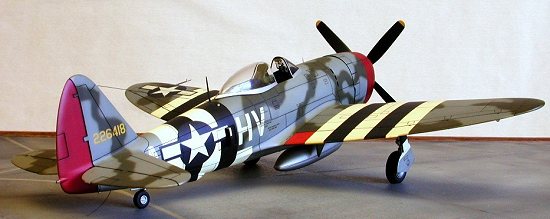 External stores consist of a pair of 500-lb bombs for the wing pylons and the
flat, oval-profiled 200-gallon drop tank for the fuselage. Plumbing molded to
the fuel tank is less-than-convincing. Curiously enough, there are flashed-over
holes on the wing bottoms that would correspond to locations for the
often-fitted multi-shot bazooka tubes. However, the rocket launchers themselves
were never included with any release of this kit.
External stores consist of a pair of 500-lb bombs for the wing pylons and the
flat, oval-profiled 200-gallon drop tank for the fuselage. Plumbing molded to
the fuel tank is less-than-convincing. Curiously enough, there are flashed-over
holes on the wing bottoms that would correspond to locations for the
often-fitted multi-shot bazooka tubes. However, the rocket launchers themselves
were never included with any release of this kit.
The decals are thick and glossy—seemingly a Monogram trademark. Minimal service stenciling is included to compliment the colorful nose art and trim colors. ETO-assigned P-47s generally carried oversized national insignia under both wings as an aid to recognition, for a total of five. However, only four star-and-bar markings are provided on the sheet. Aftermarket decal replacement is recommended.
The original release of this kit contained decals for Colonel Francis Gabreski’s camouflaged mount (42-26418) and an RAF machine based in the CBI, with Dark Green/Sea Grey uppers and ‘Sky’ below. A later "High-Tech" issue contained markings for Colonel Dave Schilling’s "Hairless Joe" and a fret of photo-etched brass parts from Teknics. The plastic parts are identical in each case.
|
CONSTRUCTION |
The initial task was to construct and install a proper cockpit, so after removing and detailing the seat from the kit’s one-piece cockpit tub I scratch-built a new seat frame, floorboard, and sidewalls. Various bits of Plastruct sheet, Evergreen rod, wound guitar string, and stretched sprue were used to detail the assembly. New seatbelts made from paper sliced from a cigarette pack and Model Technologies photo-etched buckles completed the interior.
Prior to installing the cockpit I drilled out the accessory drive cooling louvers on the fuselage halves and removed the exhaust shutters, replacing them with bits of K & S rectangular brass channel. Molded cooling vents at the rear of the turbosupercharger shroud were replaced with photo-etched stainless steel grills. I installed a baffle inside each intercooler outlet to prevent ‘see-through’, then attached the new cockpit and glued the fuselage together.
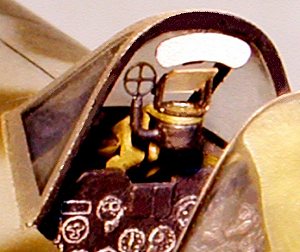 After cleaning up the seams I built a new gun sight and mount, including the
stand-by ring and bead assembly using photo-etched Waldron and True Details
pieces, then installed it below the instrument panel coaming. I attached the
windscreen and headrest with Testor’s liquid cement, electing to not install the
canopy until after painting and decaling. A pre-shaped piece of clear sprue was
cemented into a notch carved into the rudder to serve as a rear position light.
After cleaning up the seams I built a new gun sight and mount, including the
stand-by ring and bead assembly using photo-etched Waldron and True Details
pieces, then installed it below the instrument panel coaming. I attached the
windscreen and headrest with Testor’s liquid cement, electing to not install the
canopy until after painting and decaling. A pre-shaped piece of clear sprue was
cemented into a notch carved into the rudder to serve as a rear position light.
With the fuselage roughed in, I sanded and rescribed the stabilizers then attached them, using a piece of brass wire as a spar to strengthen the joints and maintain the correct dihedral angle (in this case, zero degrees). After sanding the fillets smooth I sanded and rescribed the rest of the fuselage, rebuilt the exhaust duct forward of the tailwheel well, then moved onward to the engine and cowling.
After opening up the intake cooling ducts below the engine I attached some fine-mesh screen at the rear of the diffuser vanes, both to add some detail and to prevent ‘see-through’. I installed a long piece of 1/8" aluminum tubing at the front of the engine to serve as a bearing for the propeller shaft. I purposely made it long on the inside to allow it to slip into a hole drilled into the fuselage firewall, providing additional mounting support to the engine/cowling assembly.
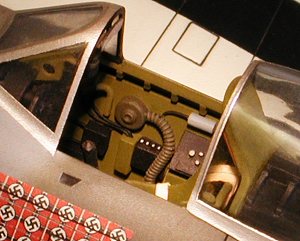 After cleaning up the prop I trimmed the plastic spindle off, installed a
3/32" aluminum tubing shaft in the rear and set it aside for the final assembly.
A short piece of tapered .008" guitar string inserted into a hole drilled
forward of the cockpit with a #80 bit was used as a companion piece to the
photo-etched ring sight behind the windscreen. The engine and cowling were
attached to the fuselage then I turned my attention to the wings.
After cleaning up the prop I trimmed the plastic spindle off, installed a
3/32" aluminum tubing shaft in the rear and set it aside for the final assembly.
A short piece of tapered .008" guitar string inserted into a hole drilled
forward of the cockpit with a #80 bit was used as a companion piece to the
photo-etched ring sight behind the windscreen. The engine and cowling were
attached to the fuselage then I turned my attention to the wings.
I opened up the shell ejection chutes, removed the wing pylons, and after gluing the halves together I cut off the guns and pitot tube, then sanded the seams to achieve a proper airfoil shape. Red and blue-green Lexan was installed at the wingtips, replicating the position lights. Sockets constructed from 1/16" aluminum tubing were added to the leading edge of the wings, to serve as receptacles for new guns and a pitot tube, scratch-built from #20 hypodermic needles.
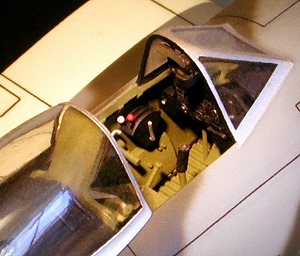 At the starboard wing root, square brass channel was fashioned into a gun
camera aperture while 1/8" tubing, crushed to an oval cross section, was used as
a cockpit fresh air intake. The red, green, and amber combat ID lights outboard
of the ejection chutes were drilled out to accept MV lenses after painting and
decaling, while on the underside of the port wing the landing light was
similarly addressed, using a large white lens.
At the starboard wing root, square brass channel was fashioned into a gun
camera aperture while 1/8" tubing, crushed to an oval cross section, was used as
a cockpit fresh air intake. The red, green, and amber combat ID lights outboard
of the ejection chutes were drilled out to accept MV lenses after painting and
decaling, while on the underside of the port wing the landing light was
similarly addressed, using a large white lens.
With the wings complete, I sanded them smooth, rescribed the surface detail, then cemented them to the fuselage with gap-filling Hot Stuff. Careful pre-fitting eliminated a few fit problems but gaps appeared nonetheless. Repeated filling and sanding were necessary to get the wing fillets properly blended and shaped.
I moved to the landing gear next, replacing most of each strut with aluminum tubing and steel wire. After installing the struts, new inner door actuators were constructed from hypodermic needles with chrome-plated straight pins used for the pistons. After assembling the kit wheels, I re-carved the tread then flattened the tires to simulate six scale tons of compression. With the basic airframe assembled I turned the droptank and its installation details.
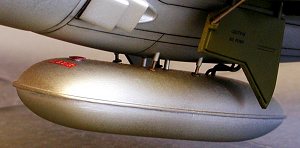 After gluing the halves together I filled the depressions for the mounting
tabs and installed a pair of steel pins to simulate the shackles. Sway brace
assemblies were built from pin heads and hypodermic needles, then attached to
the fuselage. Small diameter wire with black insulation was used to replicate
the fuel line and pressurization tubing. After a couple of test-fits I set the
tank aside for painting.
After gluing the halves together I filled the depressions for the mounting
tabs and installed a pair of steel pins to simulate the shackles. Sway brace
assemblies were built from pin heads and hypodermic needles, then attached to
the fuselage. Small diameter wire with black insulation was used to replicate
the fuel line and pressurization tubing. After a couple of test-fits I set the
tank aside for painting.
Final detailing included an ILS localizer whip antenna under the port wing, made from a piece of .010" guitar string and friction-fit into a pre-drilled hole. For the rearview mirror, I shaped a piece of sheet aluminum and polished it with Brasso, then carefully installed it underneath the windscreen bow with a drop of Crazy Glue.
The HF dorsal antenna wire was done in a method similar to that used on my P-51D.
After anchoring 2 lb-test monofilament to the fin I inserted the other end into a scratch-built insulated lead-in on the fuselage. To pull the line taut, I made a hook out of a long piece of .010" guitar string. After inserting the hook into the hole for the yet-to-be-installed tail wheel well, I fished around until I snagged the line and pulled it through the opening. With the monofilament held taut from the inside with a Kelly clamp, I glued the line solidly inside the fuselage near the fin and cut off the excess.
After installing the tail wheel and door assembly I built a mast antenna from .010" sheet brass and glued it behind the cockpit. Underneath, I built a ground strap (again using monofilament line) and attached it forward of the rudder. I cut off the ‘T’ at the bottom of the canopy slide bracket and carefully attached it to the canopy with Testor’s liquid cement. A light sanding followed by a thorough inspection of all seams and it was off to the paint shop…
|
PAINT & MARKINGS |
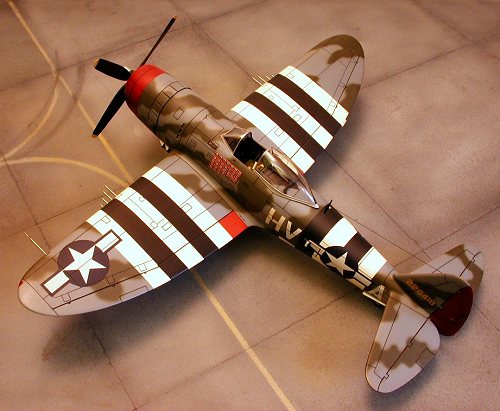 I decided to finish the model as Colonel Gabreski’s final P-47, replicating
this kit’s original-issue scheme. I was well aware of the controversy regarding
the field-expedient camouflage colors used. The flame war raged then as it
doubtless does even now. Some sources cite Dark Gray/Light Gray over NMF
undersurfaces while others swear by three shades of gray. A third faction buys
the Dark Green/Dark Sea Gray over Slate gray theory. On and on and on…
I decided to finish the model as Colonel Gabreski’s final P-47, replicating
this kit’s original-issue scheme. I was well aware of the controversy regarding
the field-expedient camouflage colors used. The flame war raged then as it
doubtless does even now. Some sources cite Dark Gray/Light Gray over NMF
undersurfaces while others swear by three shades of gray. A third faction buys
the Dark Green/Dark Sea Gray over Slate gray theory. On and on and on…
In my mind the issue is settled—in the well-publicized photo of Colonel Gabreski taxiing this ship, a reflection is plainly visible under the left stabilizer, convincing me that the ventral surfaces were unpainted aluminum. A rare color snapshot in my archives confirms that the topside colors were Slate Gray with Dark Green mottling (probably painted with locally-available RAF colors). Let the painting begin…
The D-Day stripes were first, and after masking and shooting the white areas I let them dry for a couple of weeks. In the interim, I sprayed the rudder and front of the cowling with insignia red. With the white portions of the invasion markings fully cured, I laid out the alternating lines with masking tape and painted them flat black.
After an appropriate amount of time I masked off the stripes en masse and the red areas, then finished the gear wells in zinc chromate. I stuffed them with balls of moistened Kleenex, masked the remaining ‘do-not-paint’ areas, and shot Testor’s chrome silver on the undersides.
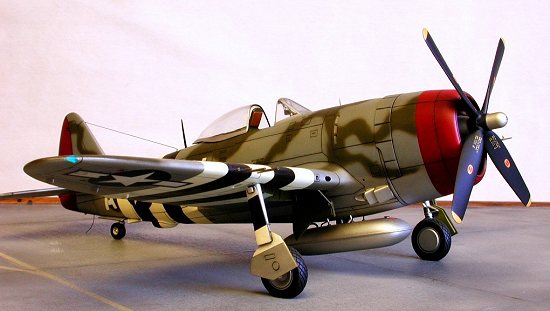 Not having any RAF-spec paint handy, I used Testor’s hot rod primer (from the
car line) and Modelmaster dark green (FS 34079) as stand-ins for the British
colors. When the topside had dried I masked the windscreen and canopy, then shot
chrome silver on the frames having first undercoated the areas with flat black.
Not having any RAF-spec paint handy, I used Testor’s hot rod primer (from the
car line) and Modelmaster dark green (FS 34079) as stand-ins for the British
colors. When the topside had dried I masked the windscreen and canopy, then shot
chrome silver on the frames having first undercoated the areas with flat black.
After removing the masks from the cowling, rudder, and invasion stripes I sprayed Testor’s GlossCote overall, then decaled the model using the ScaleMaster-printed Gabreski markings included in one of the Testors re-releases of the old Hawk P-47 kit. Stenciling was supplemented with items from MicroScale 48-429 and 48-533. After wiping the model down to remove excess decal adhesive and SolvaSet residue I sealed the decals with several heavy coats of Testor’s flat lacquer.
I highlighted the recessed surface details with Liquitex watercolor, dusted the model overall with DullCote, then removed the remaining masks. The wheels, drop tank, and propeller were painted in the appropriate colors then installed sans adhesive, while the canopy, guns, and pitot tube were attached with small drops of Elmer’s glue, carefully applied with a 000 brush. The final touch was painting the antenna wire and ground strap with a flat black enamel wash and adding the MV lenses under the wings.
|
CONCLUSIONS |
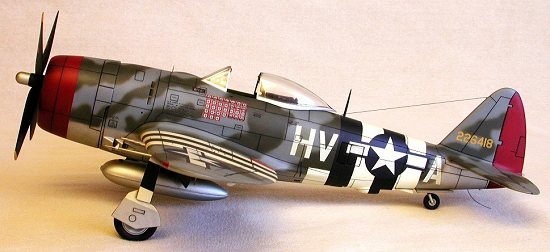 Monogram has certainly gotten a lot of mileage out of these molds, but even
after thirty-four years the assembled parts still look like a Jug. It may not
have the glitz and glamour of the new spate of wunderkits from Hasegawa
and Academy, but at one-third to one-half the price it’s still a substantial
bargain in my book.
Monogram has certainly gotten a lot of mileage out of these molds, but even
after thirty-four years the assembled parts still look like a Jug. It may not
have the glitz and glamour of the new spate of wunderkits from Hasegawa
and Academy, but at one-third to one-half the price it’s still a substantial
bargain in my book.
With good lines and proportions, the only real vice is the lack of a credible cockpit and that is easily remedied with a resin set from True Details or Verlinden. Die-hard modelers may even elect to scratch-build the interior. The Thunderbolt has been well-represented by multiple decal releases from SuperScale and AeroMaster, with nearly every unit in every theater covered.
I built several of these P-47s as a kid and a few more since, and I’ve always been rewarded with a nice-looking model. I’m sure there’s one or two more still stashed in my ‘hangar’, and any modeler with some basic tools and average skills can turn one of these kits into a competitive masterpiece.
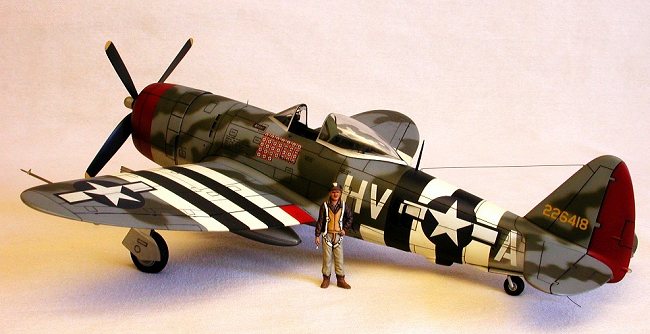
|
REFERENCES |
P-47 Thunderbolt In Action – Larry Davis; Squadron-Signal Publications
Aces Of The Eighth – Gene B. Stafford & William N. Hess; Squadron-Signal Publications
The Mighty Eighth – Roger Freeman; Scribner’s
Classic Aircraft: Fighters – Bill Gunston; Motorbooks International
AAF: The Official WWII Guide To The Army Air Forces – Reprint by Bonanza Books
Fighters Of The Mighty Eighth – William N. Hess & Thomas G. Ivie; Motorbooks International
Fighter Command: American Fighters In Original WWII Color – Jeffrey L. Ethell & Robert T.
Sand; Motorbooks International
Ó October 2001 by Roger M. Jackson
If you would like your product reviewed fairly and quickly by a site that averages thousands of visits a day, please contact me or see other details in the Note to Contributors.